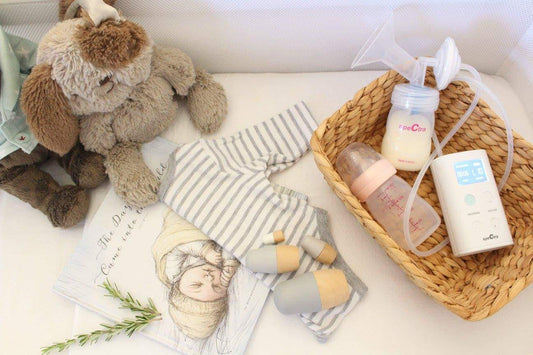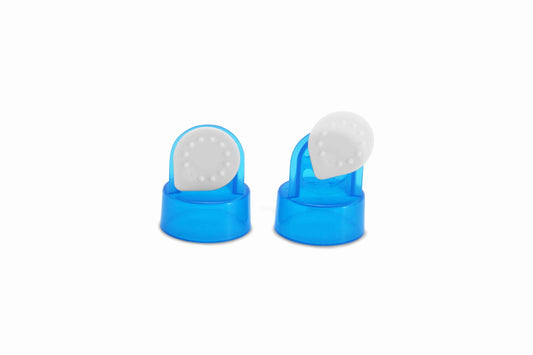Sterilise all pumping accessories except the tubing and backflow filters
Before you begin pumping, it's important that you've sterilised your pumping accessories. This includes your milk collection kits (breastshields, valves, valve membranes, bottles) and bottle accessories (caps, sealing discs, necks, and teats) which come with the Dew 350. Essentially, sterilise everything that would come in contact with the milk you're giving to your baby. It's important that you do not sterlise the tubing, short tubing, white tubing connectors (that attach into the breastshield) or backflow filters! The backflow filters prevent milk and moisture from getting into your tubing and then into your breast pump, which can cause condensation to build up in the motor and become an excellent breeding ground for mould and bacteria.
How to sterilise breast pump accessories
There are a few ways to sterilise breast pump parts. We recommend the boiling water method:- Select a pot large enough to fit all the parts without them rubbing together, such as a stock pot.
- Fill it with plenty of water to fully saturate the parts and leave plenty of room for a rolling boil. Make sure parts have plenty of room to move around and aren't nestled together as this can cause irreparable warping.
- Place on a stovetop and bring to a rolling boil.
- Boil for 5 minutes, then remove from heat.
- Allow to cool to a manageable temperature, then use a a pair of tongues to carefully remove parts.
- Set them on a clean paper towel away from a high traffic area (don't use a cloth towel as cloth can harbour bacteria).
- Allow to completely air dry prior to assembly.
How to assemble your Dew 350
Proper assembly of the milk collection kit is so important to ensure your pump works the way it should. The Dew 350 comes with everything you need to double pump, 2 of each piece (plus 2 extra backflow filters). Here's how it all goes together.

Tip: Some mums swap the short tubing with the long tubing to save on costs - you can remove the white connector bit that goes into the breastshield from the long tubing and insert it into the short tubing. This puts the short tubing and backflow filter up near the breastshield, protecting the longer tubing from moisture. Then you can just buy spare tubing to cut short when needed.
Basic maintenance of the Dew 350
To keep your Dew 350 functioning like new you'll need to plan on replacing parts regularly. Here's what you need to replace and how often.

- Valve Membrane: Replace every 2-4 weeks if exclusively pumping, and every 2 months otherwise. Replace if you ever see the membrane is not laying flat against the valve while at rest, is torn, or appears warped/distorted.
- Duck Valve: If you choose to use duck valves with your Dew 350 (they're totally compatible, and mums love them because they're easier to clean) you'll need to replace these every 4 weeks if you're exclusively pumping, or every 2-3 months otherwise. Like membranes, make sure you replace these if you ever notice damage such as the slit on the bottom not closing fully when being sucked in or if they're slipping off the breastshield while in use.
- Backflow Filter: Replace the backflow filters whenever they get wet. If it gets wet, that means it's doing its job at protecting your pump motor from moisture! You can tell it's gotten wet because the indicator strip inside will turn pink or the lines will become distorted, depending on how much moisture gets in. We recommend always having a set of these as spares just in case (the Dew 350 comes with a set of spares).

Backflow filters
- Tubing/ Short Tubing: There's no way to safely clean and sterilise tubing, so once it gets wet it will need to be replaced.
- Breastshield: Plan on replacing the breastshields every 6 months. There are a lot of crevices in our breastshields that even the most rigorous of cleaning and sterilisation routines cannot completely clean, so regularly replacing these prevents any yuck from building up. Also replace breastshields if you ever notice they are cracked or warped (sometimes they may become discolored during the sterilisation process, and that's completely okay so long as they aren't warped or cracked). You can recycle old breastshields in your regular household recycle.



